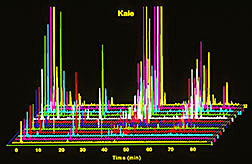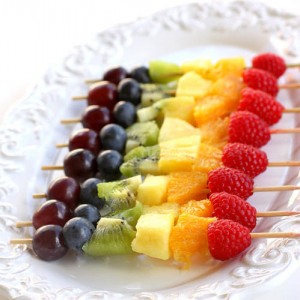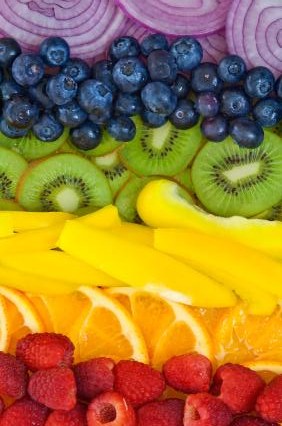Living in Vancouver, and having such an incredible bunch of kale-eating queer friends and queer-allies around me really consolidates the connection (in my mind at least) between veganism and non-conservative, non-traditional, brave, strong and progressive thinking in every area of life.
Almost all vegans could be said to have ‘queered their plate’ and taking this leap away from harmful norms can open people up to rejecting other norms that are negatively affecting their lives or the lives of their loved ones. Social justice, sexuality, non-traditional living and working spaces and relationships – everything is connected (think about the Sexual Politics of Meat). Vegans rock the boat, tip it upside down, gather friends for a potluck and use the boat as their table. Also, 8% of Canadians have (apparently) had sex in a canoe.
I digress. Back to food!
What Makes Our Foods Different Colours?
The substances that cause the wide array of natural pigmentation in food have been found to provide certain beneficial effects as regards health. A consistently beige and bland diet devoid of such protective pigments is no fun and likely very unhealthy. One reason for beige food is over-processing that leaches the pigments out in water or oil and/or destroys these healthy compounds through intense heat and oxidation.
Why Should You Care?
The colour of fruits and vegetables and the foods containing these can, therefore, tell us a bit about their nutritional value. It’s not, however, an exact visual science as some pigments are both responsible for aubergines’ amazing purple colour and carrots’ vivid orange – the result is just influenced by additional pigments and how they are bound to other substances in the foods, such as chlorophyll. In the world of colourful vegetables and fruits, variety is key as this gives you a great chance to munch your way to health by consuming carotenoids of every ilk, proanthocyanidins aplenty, and bioflavonoids galore.
Do We Even Absorb These Nutrients?
More recent researchhas called into question the actual contribution of anthocyanins and other such substances to health as it may be that bacteria in the mouth break these nutrients down before they even reach the gastrointestinal system. Some scientists are working on determining if the metabolites of these nutrients are beneficial themselves in order to find delivery mechanisms to maximise the nutrients’ value. It may be that chewing berries benefits gum health more than general health but as gum health is important anyway it still pays to eat such foods, especially as these individual nutrients are not the only thing they have to offer.
Eating the rainbow means you get the potential benefits of all of these wonderful natural micronutrients, including carotenoids. Beta-carotene is the most well-known carotenoid but its lesser known carotenoid friends, lutein, lycopene and xeathanthin may actually be more abundant in foods and more potent. Beta-carotene is converted into vitamin A in the body and is, along with other carotenoids, a powerful antioxidant. However, some research suggests that taking this nutrient in isolation, especially for smokers, actually has an increased association with cancer incidence, prompting concerns that extracted or synthetic vitamins and nutrients can have pro-oxidant effects. Whole foods. Whole foods. Whole foods!
Healthy, Colourful Fruits and Vegetables
Where to find powerful, protective pigments in tasty vegan packages (AKA wholefoods):
- bilberries
- blueberries (recently recommended for heart health!)
- carrots
- squash (excellent on pizzas)
- tomatoes (lycopene is more easily absorbed from cooked tomato products)
- apples (with skin)
- sweet potatoes
- blue/purple potatoes
- apricots
- grapefruit
- mangoes
- strawberries
- eggplant (aubergine)
- beets
- cherries
- red cabbage
- cranberries
- red onions
- kale
- broccoli
What Do Carotenoids Do?
So far around 60 carotenoids have been isolated from foods, with around 7 then found in the blood and in breast milk, suggesting that the body selectively absorbs such nutrients. Oxidised forms of lutein and zeaxanthin have been found in the blood, further suggesting that they act as antioxidants, protecting the cells from free radical attack. These carotenoids are also thought to activate enzymes involved in processes of detoxification and keeping cancerous cellular changes in check.
Lutein and Your Eyeballs
Lutein is a familiar nutrient for many with eye problems as research suggests that it can slow down age-related macular degeneration. One 1994 study by Harvard University researchers noted an association between high intake of fruits and vegetables rich in lutein and reduced risk of macular degeneration. The risk of AMD in the high intake group was half that of the lowest intake group. Lutein is a yellow-orange colour and is what provides the pigment in summer squash, apricots, peaches and oranges. However, the all-mighty kale is actually a better source of lutein, as are spinach and collard green, although chlorophyll content overrides the lutein pigment in these vegetables. Night vision may also be improved by carotenoids but the research is less conclusive on this issue.
Lycopene and Prostate Health
Lycopene, another antioxidant, enjoys a reputation for improving prostate health with a growing body of evidence supporting this notion. Found in red fruit and vegetables, especially tomatoes, lycopene has a high antioxidant capacity and was associated with a two-thirds reduction in risk of prostate cancer in men over forty who ate ten or more servings of tomato-based foods every week (compared to those eating just 1.5 servings a week).
Wait… Eating Kale is a Job?

Kale as you've never seen it before! This high-performance liquid chromatograph shows the antioxidant potential of foods - each spike represents a compound that can be oxidized and reduced.
How Much Did They Absorb?
The researchers managed to consume an average of 20mg of each carotenoid (so 60mg in total) each day by having a 6-8oz glass of tomato juice, 5oz of steamed kale and around 5.5oz of mashed sweet potato. Beta-carotene blood levels rose 116% during the three week period, lutein increased by 67% and lycopene proved to have the lowest bioavailability leading to an increase of just 26%. The latter has been seen in other studies to be more bioavailable from tomatoes when cooked, however. Oxidised metabolites of these nutrients were seen in the blood samples, suggesting that they were providing an antioxidant defence to some degree.
Cellular Protection – Rainbow Style
No changes in blood lipids were found during this trial and DNA protection was not demonstrated when assessing the presence of breakdown products in the urine. However, it did seem that much of the consumed carotenoids were providing protection within cells rather than in the blood as an analysis of colon cells by one of the researchers revealed significant concentration increases of 1000-4000% for beta-carotene.
Carotenoids Boost Immune Function
Immune function improved significantly in the study period, at least as regards the ability of T-cells to mount an attack on an antigen. T-cell proliferation increased by around a third by the end of the three week period and remained elevated for three weeks more before starting to decline again. This suggests that those eating a diet rich in kale, sweet potatoes and tomato juice may be better positioned to fight off invading bacteria and other organisms.
Wholefoods Preferable to Individual Nutrients
The benefits of these vegetables and fruits appear to come from the complete food package rather than individual vitamins, minerals or nutrients like carotenoids, however. Nutrition researchers, led by Ron Prior, at Tufts looked at the effects of blueberries, strawberries, red bell peppers, Concord grapes, and beets, as well as dark green vegetables, on quenching free radicals in the test tube. Rather than looking at specific antioxidant compounds like beta-carotene, vitamins C and E, and selenium, these nutrition scientists
note that “Much of the protection they [fruits and vegetables] confer against cancer, heart disease, and stroke may be from compounds other than these vitamins.”
Blueberries and Kale Take Top Awards in the Antioxidant Olympics
In order to test this hypothesis, Prior and colleagues began working on a way of assessing the total antioxidant capacity of individual fruits and vegetables. Results from over a dozen commonly eaten fruits, as well as from five fruit juices, twenty or more vegetables and even green and black teas showed that blueberries, strawberries, and Concord grape juice had the highest antioxidant scores overall. Two thirds of a cup of blueberries provided the same antioxidant activity as 1270mg of vitamin C or 1773 IU of vitamin E, and strawberries were just over half as potent. Three and a half ounces of kale provided the equivalent antioxidant activity of 599mg vitamin C or 837 IU of vitamin E and was twice as potent as beets and broccoli, and eight to nine times as potent as carrots and string beans.
Individual Nutrients May Actually Be Pro-Oxidising!
Interestingly, when the researchers used different types of oxidising agents (hydroxyl radicals and copper ions), found to actually cause vitamin C and E to become oxidising agents, the wholefoods maintained their antioxidant capacity. The reason for this? Prior says it is likely because “Whole fruits and vegetables contain a mixture of natural antioxidants that can protect the vulnerable compounds.” Unfortunately, Prior and his team have gone on to carry out animal research using rats rather than rounding up a load of kale-loving humans to experiment on.
Banish the Beige – Embrace the Rainbow
In conclusion, because, as usual, I got carried away, tasty, vegan wholefoods are best. Eat an array of differently coloured fruits and vegetables and you’re likely to have a plentiful mix of carotenoids, anthocyanins, and other naturally protective pigments to benefit your health. Eat the rainbow, queer your plate and, so it seems to me, you’ll have a healthier body and a healthier outlook on life.
 Want carbon-neutral webhosting with great customer service? Try DreamHost and use code 'Vegans' for a third off!
Want carbon-neutral webhosting with great customer service? Try DreamHost and use code 'Vegans' for a third off!






{ 0 comments… add one now }